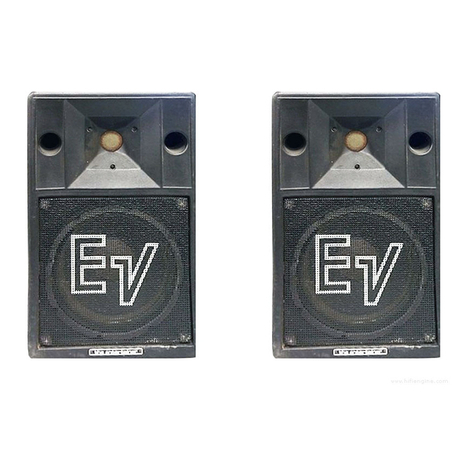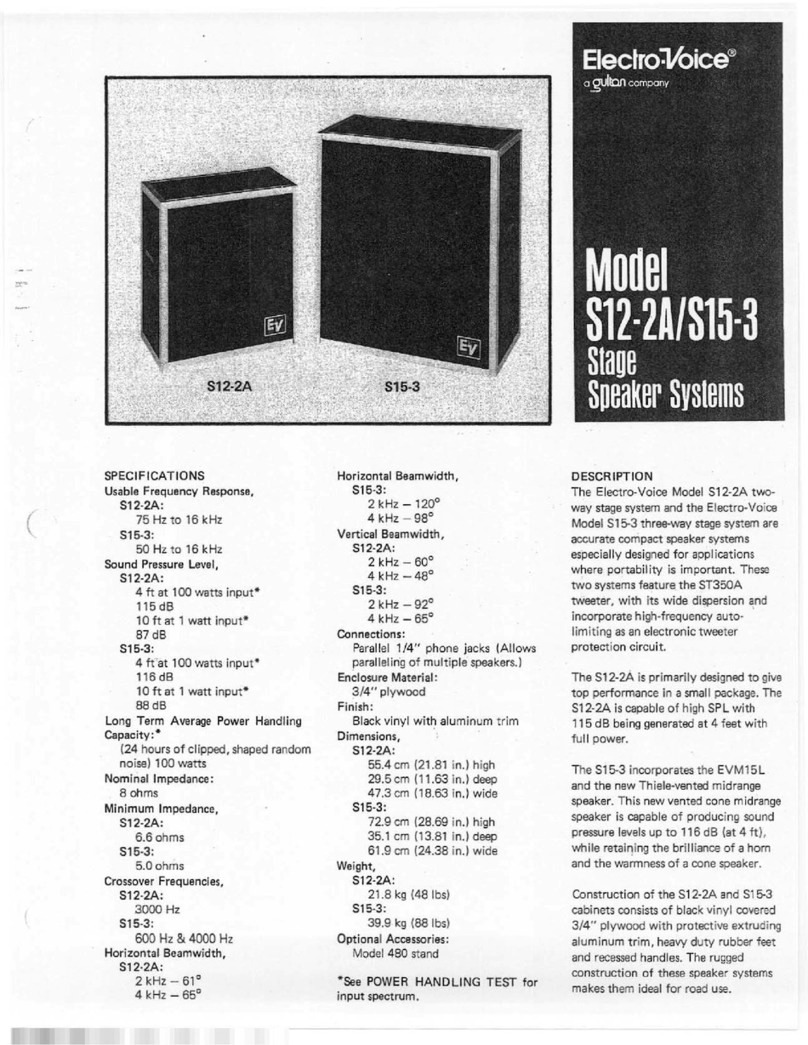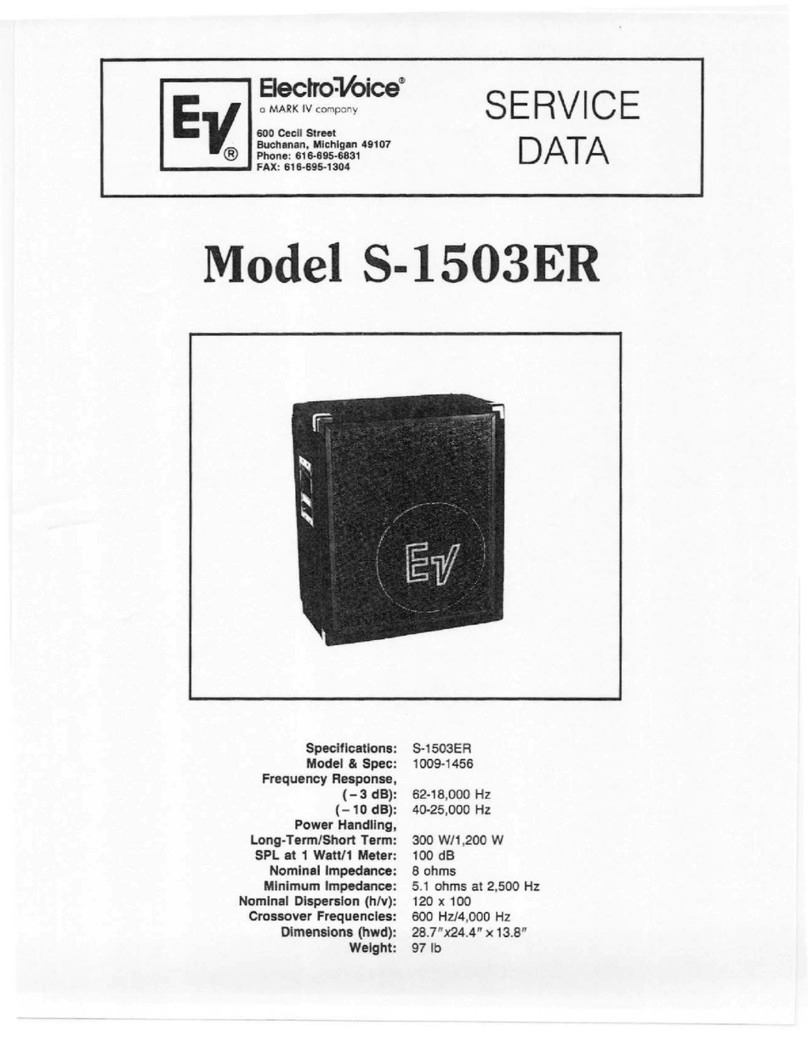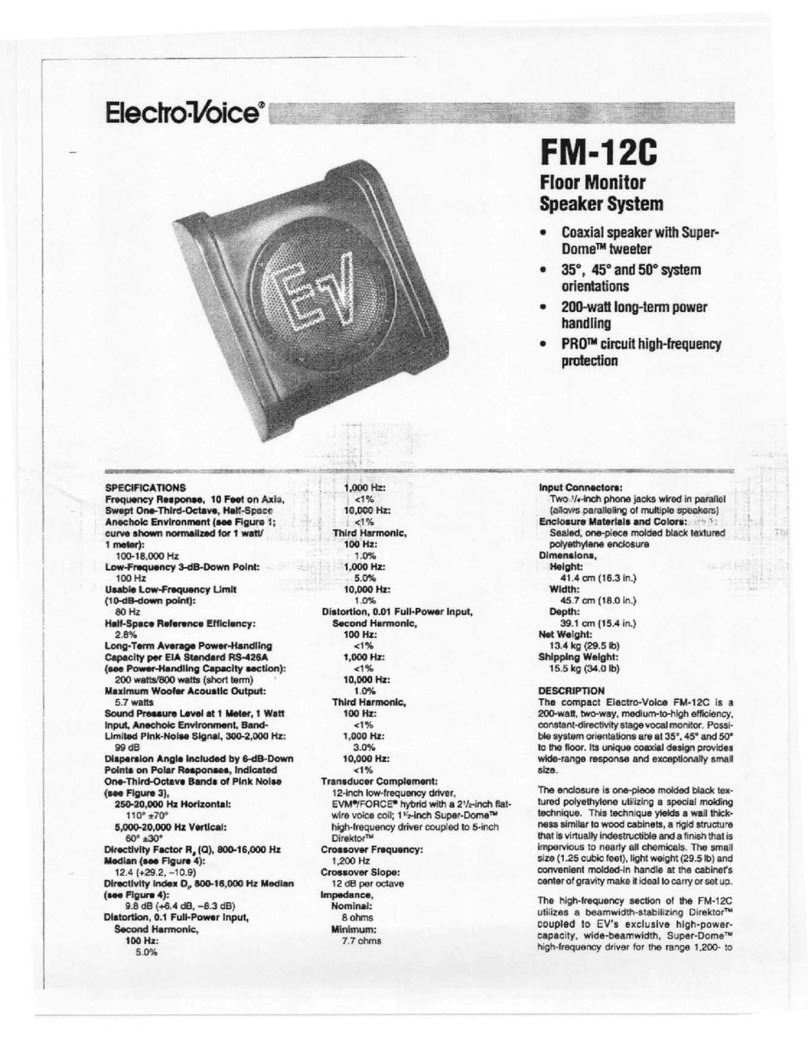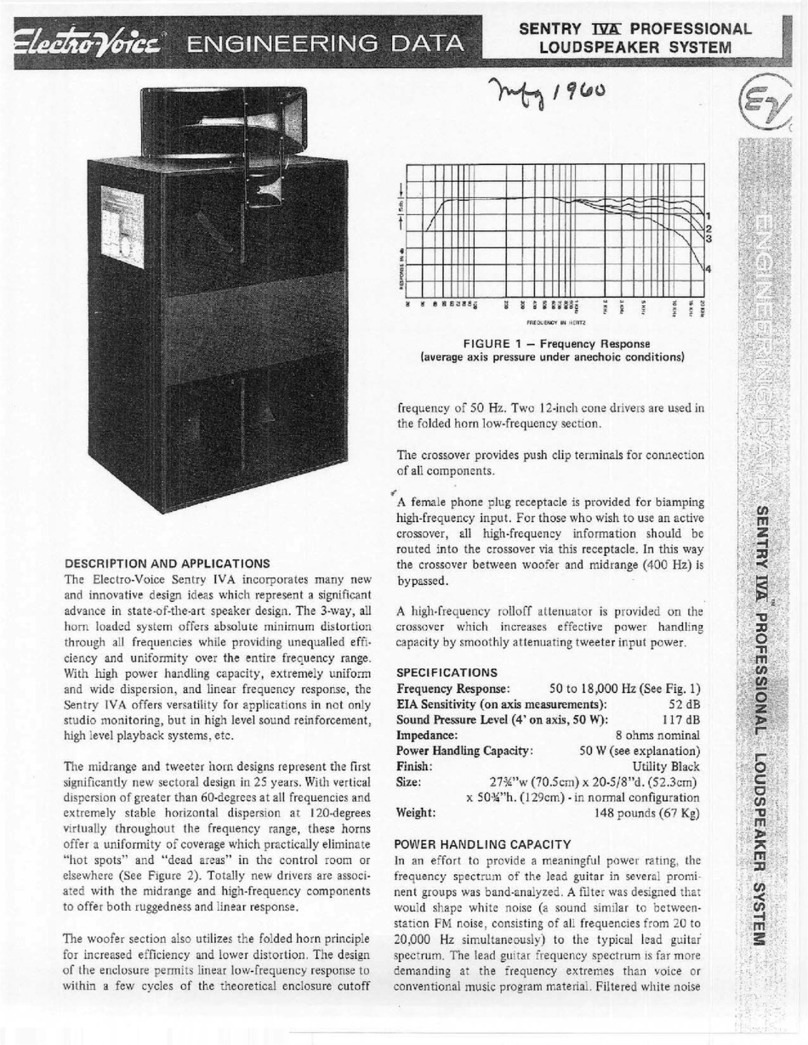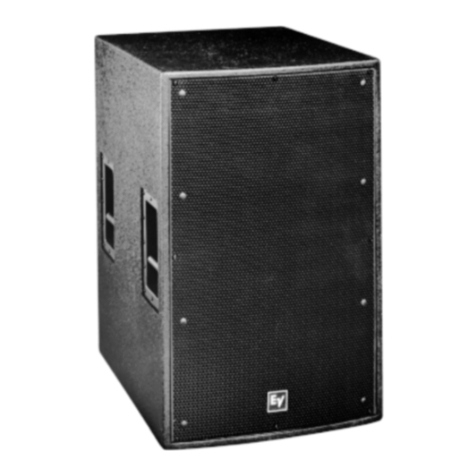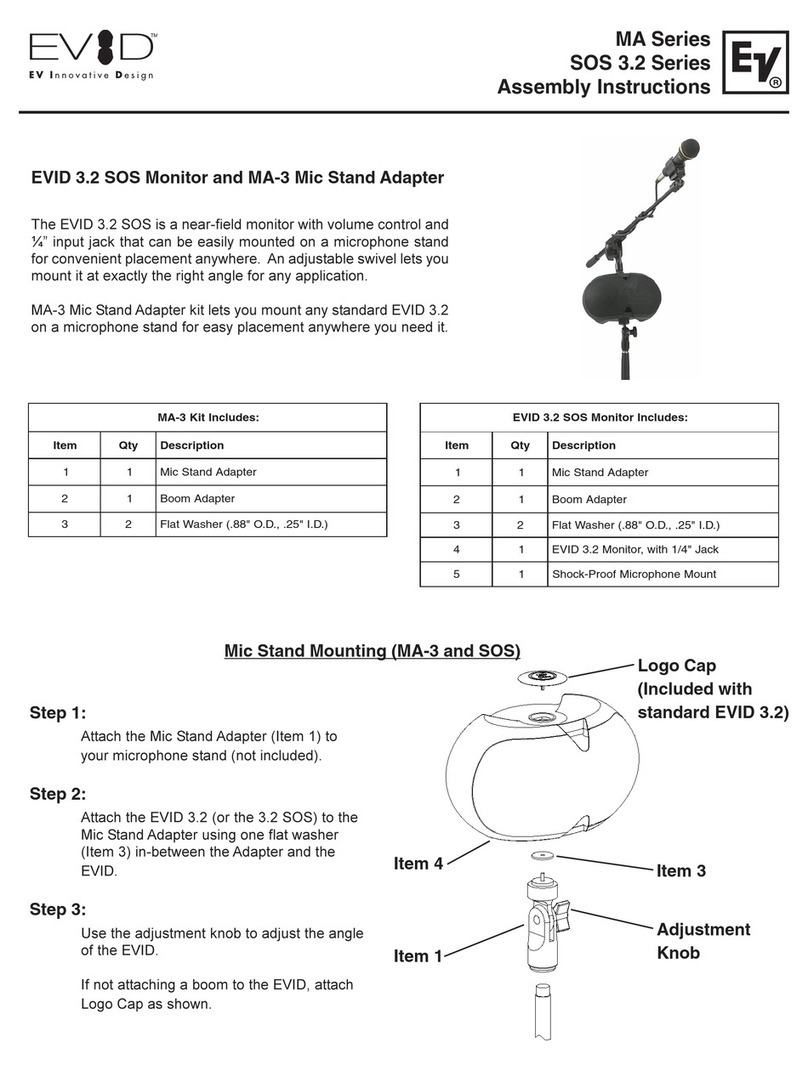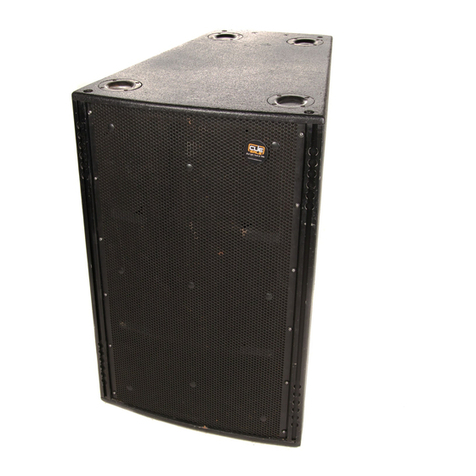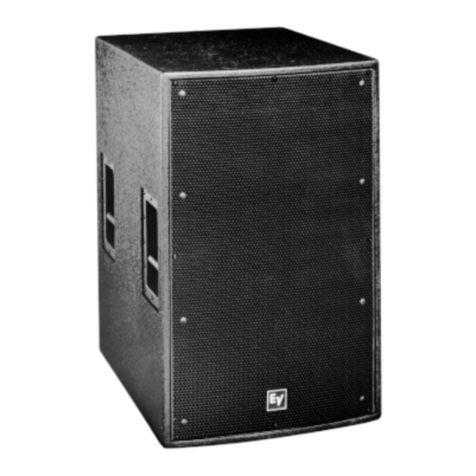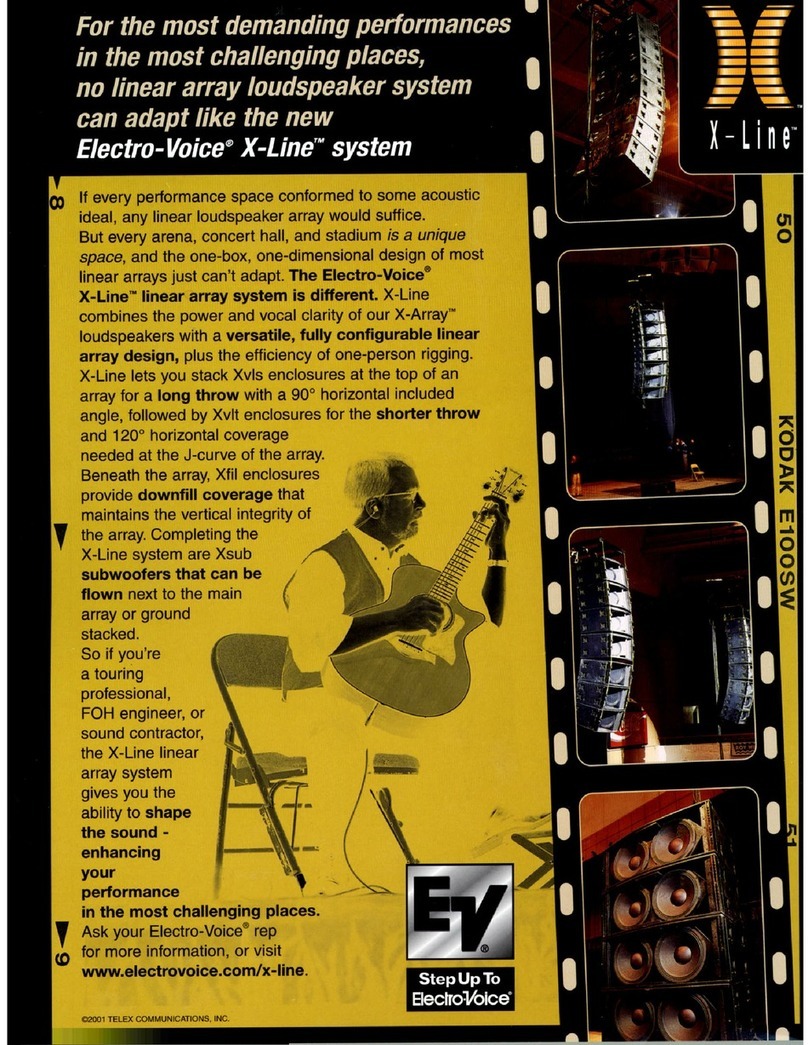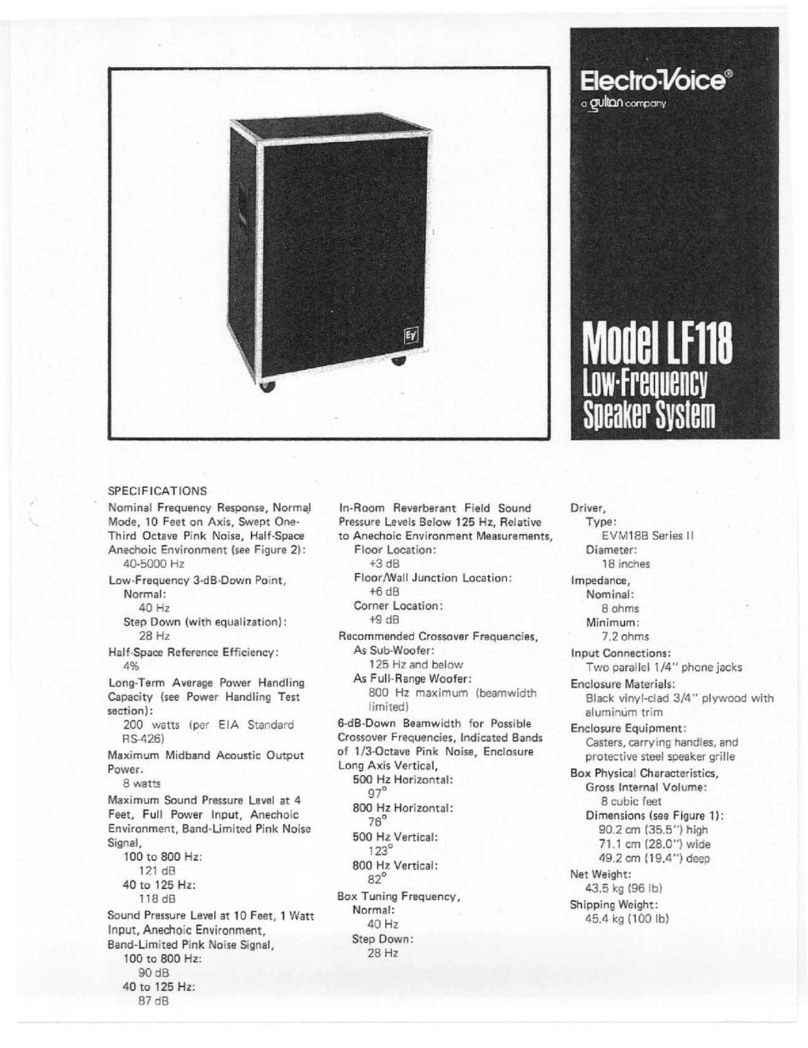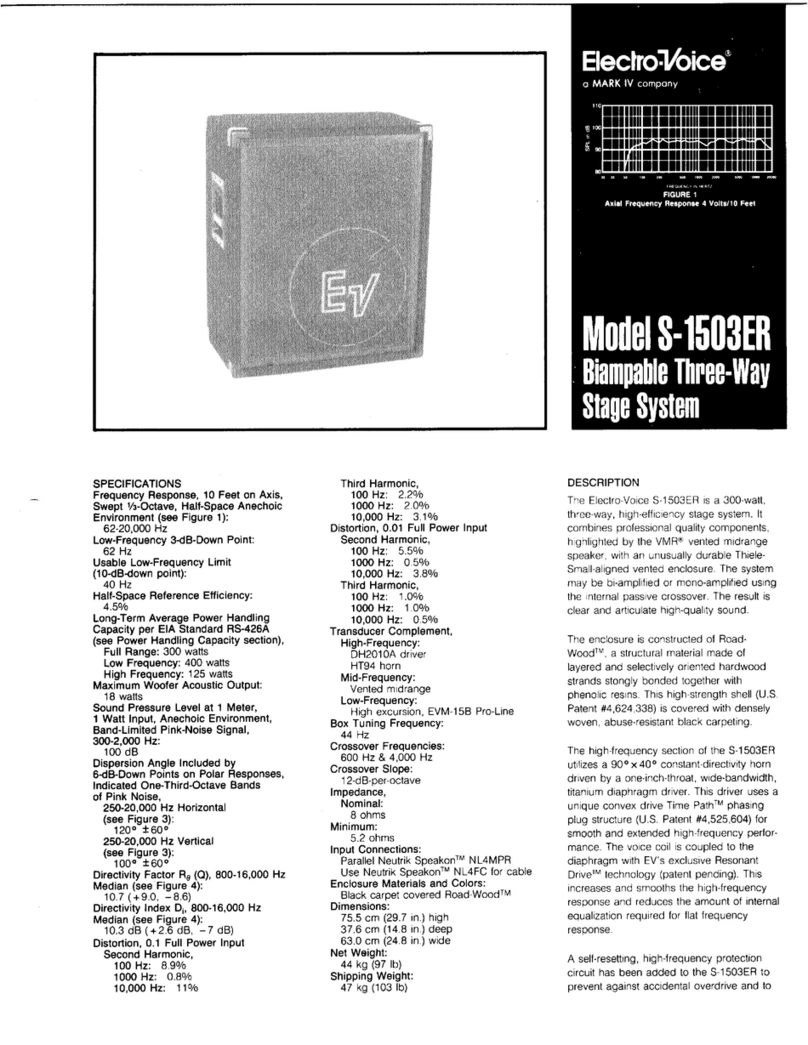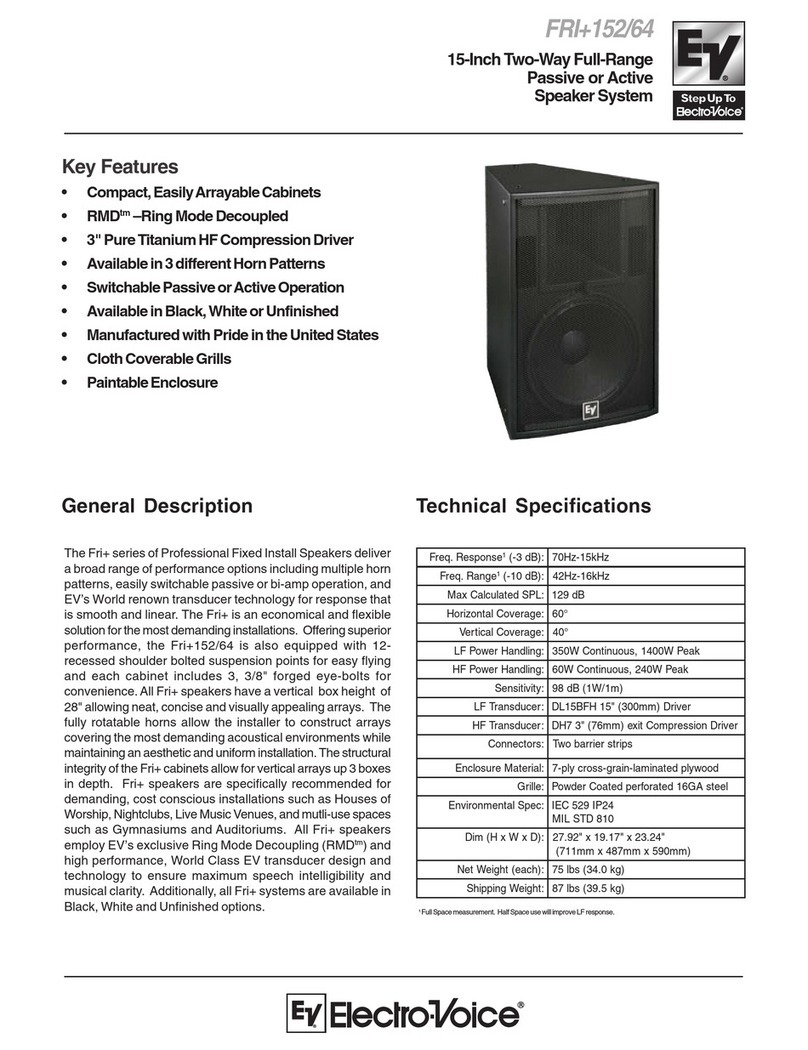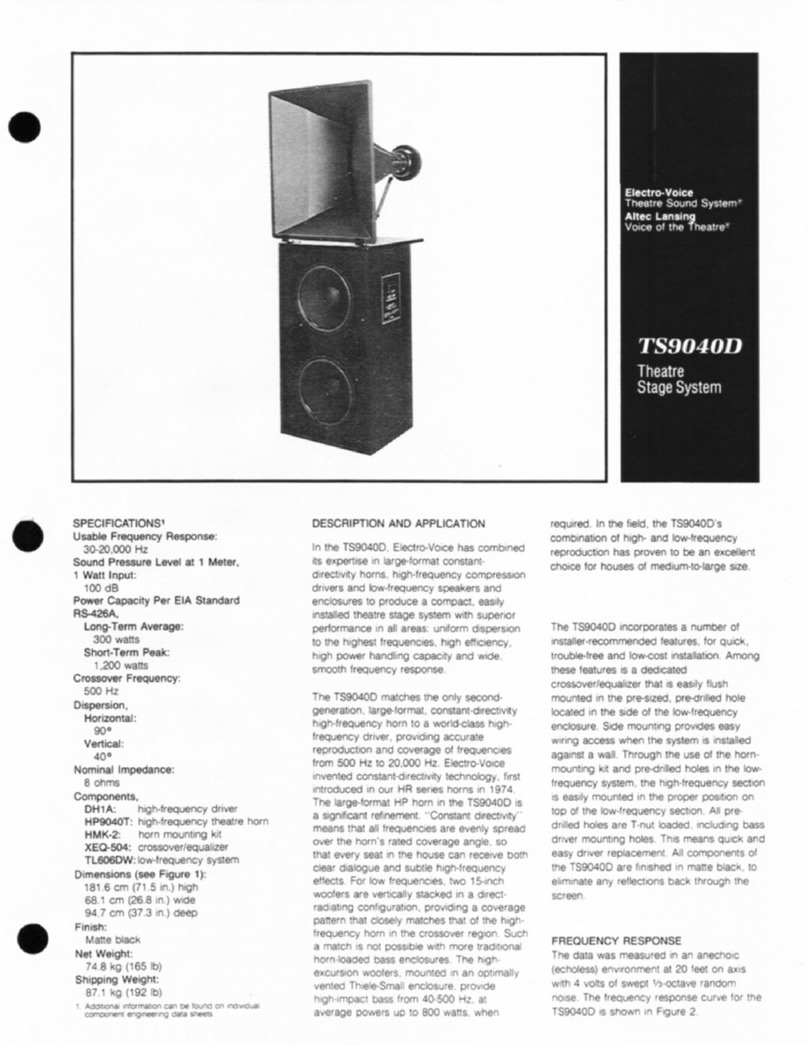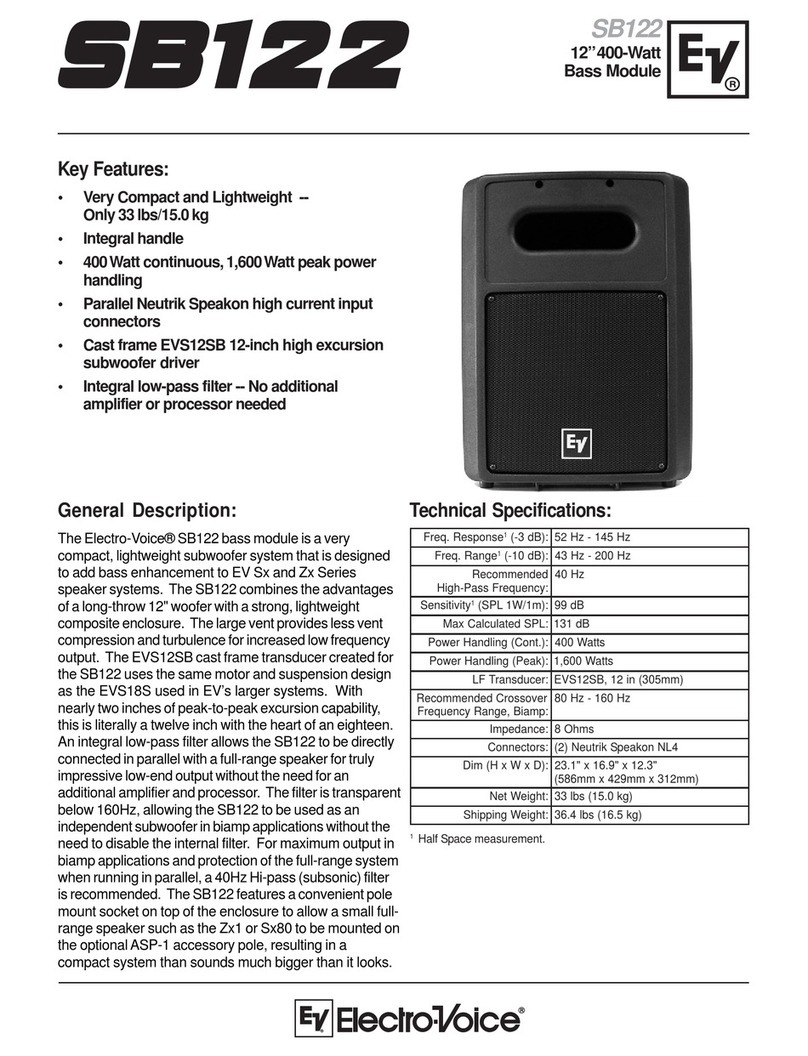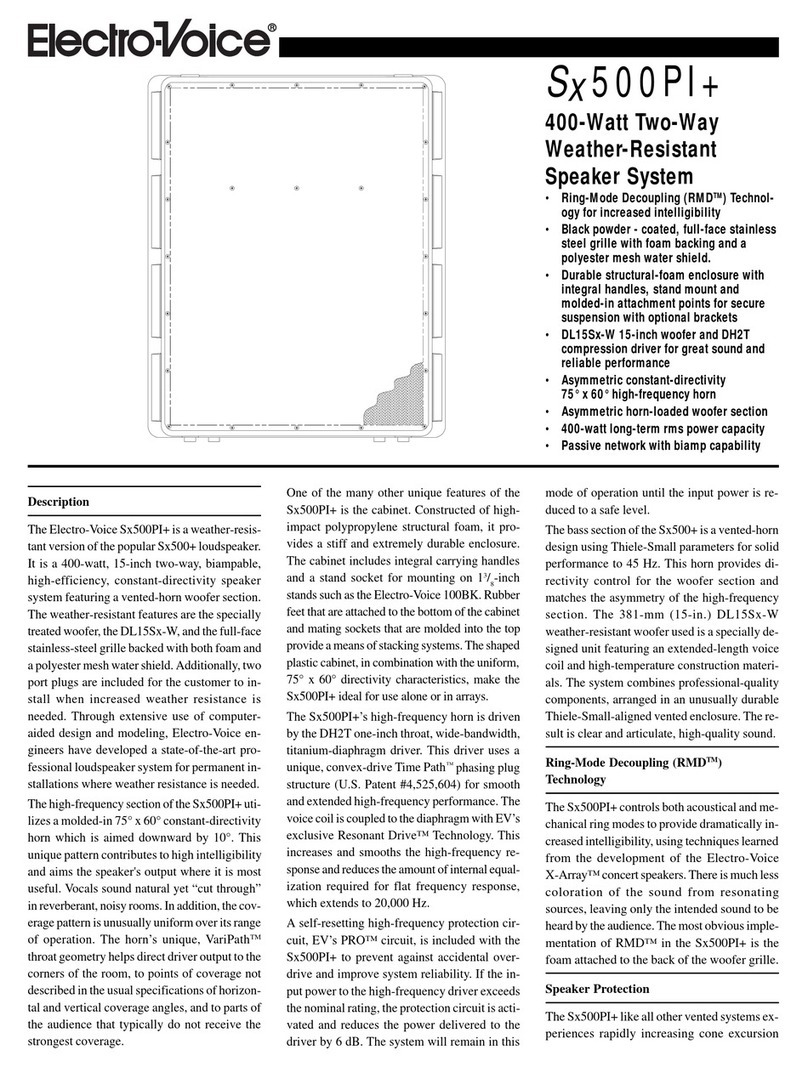
2
Installationproceduresfor anyconventional
loudspeakerarefairlywell-defined andeasytoun-
derstand:findanappropriatehangingheightand
positionthataffordsaclearpathtothelisteningarea
(such as above the center of a stage or above the
lectern in a church), and aim the loudspeaker to-
wardsthecenterorjustto the rear of center ofthe
room. With this method you hope to cover the
majorityofthe room withfairlyconsistentsound,
butthe midandhighfrequenciesnever seemtofill
perfectly. It isfrequentlyaimedalittletoofarback
and there is a large amount of slap echo, or the
frontrowis tooloud,the backrowtoosoftandthe
frontand back row corners sound muted due to a
lackofhigh-frequency energy. Othersolutionsto
filling the room have been suggested and imple-
mented, including a dual-horn format (one long
throw and one short throw). This method works
fairly well, but encounters several problems: the
addedexpenseofanotherhorn/drivercombination;
thevastlyincreasedtimetophysically install and
thentunethelevel andaimingoftwohorns;thein-
evitabledestructiveinterferencepatternsthrough-
outthelisteningarea;theexpenseofanotherampli-
fierchanneltoachieve correct impedancematch-
ing;andtheneed for averyaestheticallyclean in-
stallation,withno odd-looking (to the customer)
danglinghorns. Anothersolutionisto haveahorn
that is variable angle, in order to throw a narrow
patterntothebackoftheroom. Theproblemwith
this concept is that this doesn’t take into account
thedropin SPL betweenthenearthrow (about 25
feet) and thefar throw (about 70 feet), sothehigh
frequenciesareabout10dBdowninthebackofthe
room. To solvealloftheseproblems,the VariIn-
tense®hornswere invented,yetanother innovation
inthelongtraditionofElectro-Voice. Whenproperly
aimed,theVariIntense®hornscanprovideextremely
evenSPLthroughout anentireroom,filling inthe
corners without pushing too much energy at the
back wall, thus avoiding slap echo. The rules of
fixedinstallationhavejustchanged...
The Electro-Voice EVI-12, EVI-15 and
EVI-28enclosures arethefirstinanewgeneration
ofproblem-solving systems. Thenewsystemsare
designedasa package,witheasymounting, refin-
ishingability,lightweight,compactandunobtrusive
sizeandshape and the classic musical sound that
Electro-Voiceisknownfor. Thenewsmall-format
VI horn maintains consistent directional control
downto2,000Hz. IntheEVI-12 and EVI-15 the
VI horn is optimally crossed over to an specially
angledwoofer. Note: the12-in.driverin theEVI-
12isatadifferentanglethanthe15-in.driverinthe
EVI-15,optimizingthefloorpatternwiththediffer-
ingdirectivitiesof thetwodrivers. Inthe EVI-28,
theVIhorniscrossedovertoapairofvertically-
arrayed8-inchwooferswithaproprietarytechnique
thatprovidesdelay,amplitudeandfrequencyshad-
ingtothetwo woofers.
TheEVI-12,EVI-15andEVI-28systemsare
installed just like any conventional loudspeaker,
keepinginmindafewsimpleguidelines. Letme
prefacetheseguidelineswitha simple but impor-
tantcomment:theVI systemsareextremelyversa-
tileand willworkinalarge varietyofapplications.
Theywillworkwellwithtallceilings,shortceilings,
rectangularrooms,slightlytrapezoidalroomsanda
wholehostofoddshapessolongasthecoverage
area is fairly close to rectangular. The larger
EVI-12andEVI-15havebeentestedinroomswith
12-footceilingsandperformedverywell,although
with reduced width of throw. A single EVI-12
wasinstalledinaroom 75-footby150-footandan
averageRT60of4.5inthemidbandandperformed
verywellwithgoodintelligibilityandaminimumof
slapecho. Ithasbeenthoughtinthepastthat ifthe
floorpatterndoesnotfittheVIhornexactly,thenit
cannotbeusedat all. This is notthecase,andif it
werethecase,wecould notusestandard constant-
directivityhornsinmostapplicationseither. The
largerVIsystemshavean “optimum”roomthat is
approximatelytwicethe heightinwidthand three
timestheheight in length. Thisistheideal condi-
tion, but the figures and descriptions that follow
shouldgiveyouagoodfeelforthewide-range ca-
pabilitiesofthesystems.
EVI-12andEVI-15Installation:
The nominal floorplan that the system will
coverwithequalSPLisapproximatelytwo“units”
widebythree“units”long,wheretheheightof the
loudspeakerdefinesthesize of the“unit.” Forex-
ample,iftheloudspeakeris18feetabovethefloor, it
willtypicallycoverafloorplanofabout36feetwide
by54feetlong. Inthistypicalinstallation(seeFig-
ure1),thebackpaneloftheloudspeakerismounted
approximately0.6units (about 11feet)backfrom
thefirstrowandhasa nominal angle of the topof
theenclosureparalleltothefloor or slightly tilted
back (2 to 3 degrees). For rooms that are much
longerthannormal,theVIsystemsareveryeasyto
aimand position to fill the entire length. Experi-
mentsinactuallisteningroomshaveshownthatwith
